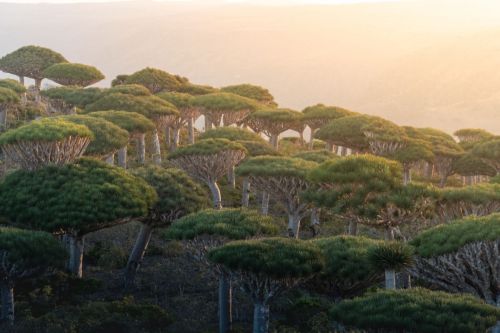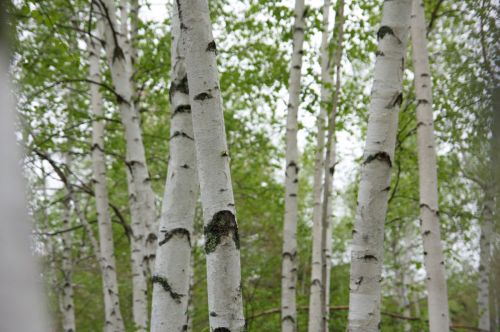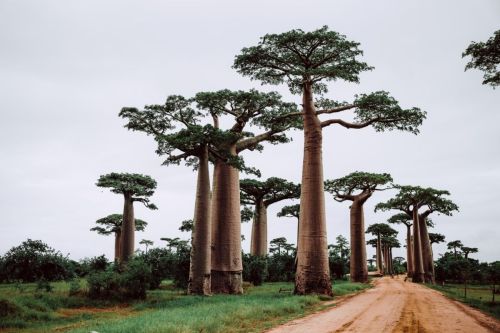Trees are an important part of the Earth's ecosystem, providing habitats for many communities of living organisms. They stabilize soil, prevent desertification, play a role in climate control, and help maintain biodiversity and ecosystem balance.
They are invaluable to humans for many reasons, ranging from recreation and health to industrial use for wood, resin, rubber, paper or fuel.
They are a source of food and medicinal substances. Possessing the ability of longevity, they are silent witnesses of history and its monuments.
Until recently, we did not know what the first representatives of trees looked like because none of the fossil specimens had been found complete. It wasn't until 2007 that the crown of the tree was found, making it possible to learn about them in their entirety.
They have a woody single stem (trunk) or several main stems, as well as woody branches that form the crown.
They are distinguished from shrubs and bushes by having a trunk or stems that branch only from a certain height.
These include tree ferns, sagebrush, palms, yucca, dracaena, and pandanus.
There are currently about 3 trillion 40 billion trees growing in the world.
This science deals, among other things, with the morphology of trees, their anatomy, geography and genetics, as well as the introduction of non-native plant species and their acclimatization. The study and observation of trees is carried out in arboreta, botanical gardens and dendrological gardens.
This represents 20% of all seed plant species. 45% of the tree species belong to the 10 largest families. Three families are particularly abundant in trees: legume, bedstraw, and myrtle. The largest number of trees grows in places with high biodiversity: Brazil, Colombia and Indonesia.
In terms of use, they are divided into fruit, ornamental, forest trees.
Seeds vary widely in size and shape. Some of the largest seeds come from trees, but the largest tree, the Giant sequoia (Sequoiadendron giganteum), produces some of the smallest tree seeds.
In order to disperse seeds, they are often equipped with features that facilitate wind dispersal, such as wings (birch, ash, maple).
Seeds are also dispersed by animals, thanks to their edible fruits. Seeds of conifers (the largest group of gymnosperms) are embedded in the cone. Sometimes the seeds are trapped in the cones for many years, waiting for an event to release them. Such an event is sometimes fire, which stimulates the release and germination of pine seeds while enriching the soil with wood ash and removing competing vegetation. Many angiosperms (including Acacia cyclops and Acacia mangium) have seeds whose germination is also stimulated by high temperatures.
Within a few weeks, lateral roots appear and branch out laterally. In most trees, the taproot withers away, leaving only the lateral roots, which spread far out to the sides. The roots serve to anchor the tree to the ground, collect water and nutrients, and distribute them to all parts of the tree. Roots need oxygen to breathe, and only a few species, such as mangroves (they develop what are called aerial roots) and pond cypress (Taxodium ascendens), can live in permanently waterlogged areas.
Some fungi are specific to only one tree species, while others associate with multiple species. The tree obtains minerals from the mycelium, and the mycelium obtains carbohydrates, which are products of photosynthesis. Mycelial tufts can connect different trees to form a network, carrying nutrients and various types of information.
Fungi promote root growth and help protect trees from predators and pathogens. They also protect trees from pollution by accumulating heavy metals in their tissues. Fossil evidence indicates that the relationship between tree roots and mycorrhizal fungi has existed since the early Paleozoic, four hundred million years ago, when the first vascular plants colonized dry land.
These bacteria live in the root papillae. This allows these trees to live in low nitrogen environments.
It is an inosculation process, biologically similar to grafting, a natural phenomenon in which the trunks, branches, or roots of two trees grow together. In forestry, such trees are called gemels, from the Latin word meaning "pair."
The trunk and older, thicker branches are woody, while the young branches become woody at the end of the growing season.
Its main purpose is to raise the leaves above the ground, allowing the tree to break through other plants and gain access to light. The trunk transports water and nutrients from the roots to the above-ground parts and distributes nutrients produced by the leaves to all other parts, including the roots. The outermost layer of the trunk is the bark, which is composed mainly of dead cells.
The tree constantly increases the diameter of its trunk and branches throughout its life. A layer of constantly dividing cells called the cambium, located under the bark of the tree, is responsible for this growth.
The next phase is the rapid growth phase. Over time, the rate of growth slows and eventually stops altogether. Such specimens can survive for a very long time.
The first tree may have been Wattieza (a close relative of modern ferns and horsetails), whose Middle Devonian (about 385 million years ago) fossils were found in New York State in 2007. Prior to this discovery, the earliest known tree was Archaeopteris (its leaves resembled a fern).
Both specimens reproduced by spores, not seeds. They are thought to be the link between ferns and the gymnosperms that evolved in the Triassic. Gymnosperm spores include conifers, sagebrush, and ginkgo trees.
Fossil representatives of ginkgo are known from numerous fossils, the oldest of which date to about 280 million years ago.
The only relic of this group has remained until modern times ginkgo biloba.
In the Tertiary, trees colonized almost all the land. Oaks, birches, cedars, maples, and lindens/basswoods appeared. In Europe, many tree species became extinct during the glaciations, so the European flora is poorer than, for example, the American one.
For the ancient Celts, certain trees, especially oak, ash, and hawthorn, had special significance as a source of fuel, building materials, ornaments, and weapons.
Trees were often regarded as oracles. In Greek mythology, driads (tree nymphs) inhabited trees.
West Africans from the Ubangi River region plant a tree when a child is born. When the tree blooms, it's time for marriage. Gifts are left on the tree, and it is believed that a person's spirit lives on in the tree after death.
In Norse mythology, Yggdrasil is the central cosmic tree, with roots and branches that reach across worlds.
In India, Kalpavriksha is a wish-fulfilling tree, one of the nine jewels that emerged from the ocean.
In the biblical creation story, the Tree of the Knowledge of Good and Evil was planted by God in the Garden of Eden.
Sacred groves are found in China, India, and African countries, among others. They serve as places where deities live and where all living creatures are sacred or companions of the gods.
Because of their status as protected places, sacred groves can be relics of an ancient forest, characterized by much greater biodiversity than the surrounding areas.
The tallest known specimen on earth is the coast sequoia (Sequoia sempervirens) in Redwood National Park in California. It is named Hyperion and is 115.85 meters tall. The theoretical height limit has therefore not yet been reached.
The tallest known broad-leaved tree is a representative of the mountain ash (Eucalyptus regnans), also known as swamp gum, a 100.5 meter high plant growing in Tasmania.








